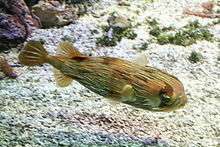Long-spine porcupinefish
| Longspined porcupinefish | |
|---|---|
 | |
| Scientific classification | |
| Kingdom: | Animalia |
| Phylum: | Chordata |
| Class: | Actinopterygii |
| Order: | Tetraodontiformes |
| Family: | Diodontidae |
| Genus: | Diodon |
| Species: | D. holocanthus |
| Binomial name | |
| Diodon holocanthus Linnaeus, 1758 | |
 | |
| Distribution of the Long-Spine Porcupinefish | |
Diodon holocanthus, known commonly as the longspined porcupinefish or freckled porcupinefish among other vernacular names, is a species of marine fish in the family Diodontidae.[2]
Diet
The species' diet includes sea urchins and hard-shelled mollusks.[3]
Distribution
The Longspined porcupinefish has a circumtropical in distribution, being found in the tropical zones of major seas and oceans:
- In the Atlantic it is found from Florida and the Bahamas to Brazil and in the Eastern Atlantic from 30°N to 23°S, as well as around South Africa.
- And In the western Indian Ocean from the southern Red Sea to Madagascar, Réunion and Mauritius.
- Also In the Pacific Ocean from southern Japan to Lord Howe Island, and east to the Hawaiian and Easter islands. Also from southern California to Colombia and the Galapagos Islands.[4]
Description


Pale in colour with large black blotches and smaller black spots, these spots becoming fewer in number with age. Has many long, two-rooted depressible spines particularly on its head. The teeth of the two jaws are fused into a parrot-like "beak". Adults may reach 50 cm (20 in) in length.[5] The only other fish with which it might be confused is the black-blotched porcupinefish, (Diodon liturosus) but it has much longer spines than that species.[6]
Diet
The porcupine fish is an omnivore that feeds on mollusks, sea urchins, hermit crabs, snails, and crabs during its active phase at night.[7] They use their beak combined with plates on the roof of their mouths to crush their prey such as mollusks and sea urchins that would otherwise be indigestible.[8]
Habitat
They are found over the muddy sea bottom, in estuaries, in lagoons or on coral and rocky reefs around the world in tropical and subtropical seas.[9]
Spawning
Spawns at the surface at dawn or at dusk in pairs or in groups of males with a single female; the juveniles remain pelagic until they are at least 7 cm (3 in) long.[5] Young and sub-adult fish sometimes occur in groups.
Uses
It is used in Chinese medicine, and is captured at the surface with a hand net. It is poisonous if not prepared correctly. It is also found in the aquarium trade.
References
- ↑ Leis, J.L., Matsuura, K., Shao, K.-T., Hardy, G., Zapfe, G., Liu, M., Jing, L., Tyler, J. & Robertson, R. (2015). Diodon holocanthus. The IUCN Red List of Threatened Species doi:10.2305/IUCN.UK.2015-4.RLTS.T193817A2282138.en
- ↑ "Common Names List – Diodon holocanthus". FishBase. Retrieved 7 September 2014.
- ↑ Tristan Lougher (2006). What Fish?: A Buyer's Guide to Marine Fish. Interpet Publishing. ISBN 978-1-84286-118-9.
- ↑ Froese, Rainer and Pauly, Daniel, eds. (2007). "diodon holocanthus" in FishBase. 6 2007 version.
- 1 2 Lieske, E. and Myers, R.F. (2004) Coral reef guide; Red Sea London, HarperCollins ISBN 0-00-715986-2
- ↑ "Black-blotched porcupinefish: Diodon liturosus Shaw, 1804". Australian Museum. Retrieved 2013-12-15.
- ↑ Leis, J.M., 2001. Diodontidae. Porcupine fishes (burrfishes). p. 3958-3965. In K.E. Carpenter and V. Niem (eds.) FAO species identification guide for fishery purposes. The living marine resources of the Western Central Pacific. Vol. 6. Bony fishes part 4 (Labridae to Latimeriidae), estuarine crocodiles. FAO, Rome.
- ↑ "Porcupinefishes". Australian museum. Retrieved 2013-12-15.
- ↑ Kuiter, R.H. and T. Tonozuka, (2001). Pictorial guide to Indonesian reef fishes. Part 3. Jawfishes – Sunfishes, Opistognathidae – Molidae. Zoonetics, Australia. pp. 623–893.
External links
| Wikimedia Commons has media related to [[commons:Category:Diodon holocanthus|]]. |
- http://www.marinespecies.org/aphia.php?p=taxdetails&id=127402
- http://fran.cornu.free.fr/affichage/affichage_nom.php?id_espece=1209
![]() Media related to Diodon holocanthus at Wikimedia Commons
Media related to Diodon holocanthus at Wikimedia Commons
![]() Data related to Diodon holocanthus at Wikispecies
Data related to Diodon holocanthus at Wikispecies
